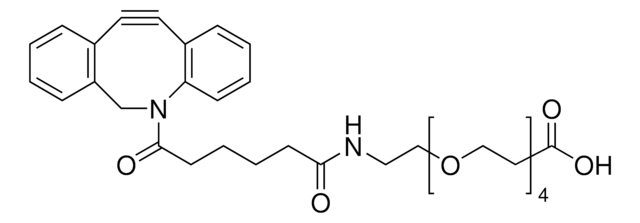If this product has an expiration or retest date, it will be shown on the Certificate of Analysis (COA, CofA). If there is no retest or expiration date listed on the product's COA, we do not have suitable stability data to determine a shelf life. For these products, the only date on the COA will be the release date; a retest, expiration, or use-by-date will not be displayed.
For all products, we recommend handling per defined conditions as printed in our product literature and website product descriptions. We recommend that products should be routinely inspected by customers to ensure they perform as expected.
For products without retest or expiration dates, our standard warranty of 1 year from the date of shipment is applicable.
For more information, please refer to the Product Dating Information document: https://www.sigmaaldrich.com/deepweb/assets/sigmaaldrich/marketing/global/documents/449/386/product-dating-information-mk.pdf
Wichtige Dokumente
760749
Dibenzocyclooctyne-PEG4-biotin conjugate
for Copper-free Click Chemistry
Synonym(e):
Polyethylene glycol, DBCO-PEG4-biotin
Größe auswählen
About This Item
Empfohlene Produkte
Qualitätsniveau
Form
solid
Eignung der Reaktion
reaction type: click chemistry
Lagertemp.
−20°C
SMILES String
O=C(CCCC[C@@H]1SC[C@@H]2NC(=O)N[C@H]12)NCCOCCOCCOCCOCCC(=O)NCCC(=O)N3Cc4ccccc4C#Cc5ccccc35
InChI
1S/C39H51N5O8S/c45-35(12-6-5-11-34-38-32(28-53-34)42-39(48)43-38)41-18-20-50-22-24-52-26-25-51-23-21-49-19-16-36(46)40-17-15-37(47)44-27-31-9-2-1-7-29(31)13-14-30-8-3-4-10-33(30)44/h1-4,7-10,32,34,38H,5-6,11-12,15-28H2,(H,40,46)(H,41,45)(H2,42,43,48)/t32-,34-,38-/m0/s1
InChIKey
LNHSQAOQVNHUGL-QRBHCBQLSA-N
Verwandte Kategorien
Allgemeine Beschreibung
Anwendung
Leistungsmerkmale und Vorteile
Lagerklassenschlüssel
11 - Combustible Solids
WGK
WGK 3
Flammpunkt (°F)
Not applicable
Flammpunkt (°C)
Not applicable
Hier finden Sie alle aktuellen Versionen:
Besitzen Sie dieses Produkt bereits?
In der Dokumentenbibliothek finden Sie die Dokumentation zu den Produkten, die Sie kürzlich erworben haben.
Kunden haben sich ebenfalls angesehen
Artikel
Copper-free click chemistry is an alternative approach to click chemistry that proceeds at a lower activation barrier and is free of cytotoxic transition metal catalysts.
Explore the principles and applications of click chemistry in drug discovery, highlighting efficient reactions that streamline the synthesis of bioactive compounds.
-
How can I determine the shelf life / expiration / retest date of this product?
1 answer-
Helpful?
-
-
How is shipping temperature determined? And how is it related to the product storage temperature?
1 answer-
Products may be shipped at a different temperature than the recommended long-term storage temperature. If the product quality is sensitive to short-term exposure to conditions other than the recommended long-term storage, it will be shipped on wet or dry-ice. If the product quality is NOT affected by short-term exposure to conditions other than the recommended long-term storage, it will be shipped at ambient temperature. As shipping routes are configured for minimum transit times, shipping at ambient temperature helps control shipping costs for our customers. For more information, please refer to the Storage and Transport Conditions document: https://www.sigmaaldrich.com/deepweb/assets/sigmaaldrich/marketing/global/documents/316/622/storage-transport-conditions-mk.pdf
Helpful?
-
Active Filters
Unser Team von Wissenschaftlern verfügt über Erfahrung in allen Forschungsbereichen einschließlich Life Science, Materialwissenschaften, chemischer Synthese, Chromatographie, Analytik und vielen mehr..
Setzen Sie sich mit dem technischen Dienst in Verbindung.












